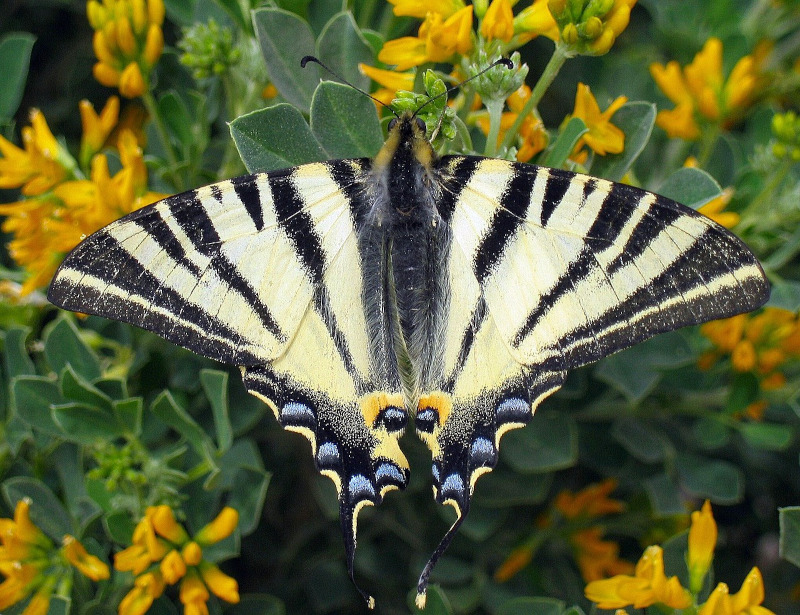
Scarce Swallowtail Facts
- This gorgeous variety of Lepidoptera is most frequently known by the deceptive common name of the Scarce Swallowtail. The insect does have a few other, less often used titles, though. They include the terms sail swallowtail and pear-tree swallowtail.
- Inside of scientific conversations, however, it’s likely better known by its technical title. Unfortunately, that’s an extremely difficult appellation for the layperson to pronounce. That’s because this natural marvel holds the formal moniker of Iphiclides podalirius.
- The invertebrate received that tongue-twisting official title due to the efforts of the esteemed Swedish zoologist, Carl Linnaeus. He recorded the first formal recognition of the creature as a separate and distinct species. This deed occurred in 1758.
- In addition to its pure visual appeal, it also stands out for another reason. That’s true since entomologists currently recognize four distinct subspecies of the marvel of evolution. Many of these share the same habitat range, often creating confusion.
- Pleasantly, despite the name, the Scarce Swallowtail appears to be maintaing an stable and sufficient population base. That fortunate situation further seems to hold true throughout its entire range. The IUCN, therefore, currently lists it as Least Concern.
- The colorful work of Nature nevertheless faces several potential threats to its existence, at least. In this, it follows the pattern shared by many species. Many of its dangers stem from the actions of humans. They include habitat loss and ongoing climate change.
Related Articles
Scarce Swallowtail Physical Description
The fabulous Scarce Swallowtail entrances most individuals fortunate enough to spot one. Unlike some of its many relatives, though, it does so for several reasons. Its sheer beauty obviously qualifies as one. Yet it also captures the attention due to its sheer physical size.
That’s due to the fact that the Arthropod ranks as an above-average size butterfly. Like many such species, it also displays a certain amount of the physiological characteristic of sexual dimorphism. In its specific case, that trait manifests itself in terms of those measurements.
More precisely, females attain a greater average wingspan than their male counterparts. The difference remains quite minor, though. As a result of this tendency, distinguishing the genders by visual means only can be extremely difficult for the untrained observer.
The males attain an average width of wing equaling roughly 2.4 – 3.1 in (6 – 8 cm). Females, meanwhile, typically grow to approximately 2.4 – 3.5 in (6 – 9 cm). Exceptional specimens do occur, of course, regardless of gender. But even these rarely do so by very much.
In terms of appearance, the sexes of the Scarce Swallowtail appear identical. The overall background coloring varies between a pale yellow and a creamy white. On the upper and lower sides of the front wings, six black stripes and wedge-shaped markings appear.
Both sides of the hindwings, however, show a different pattern. These display two back stripes, and blue crescent-shaped markings on the outer edges. An oblong, orange shaded spot also appears on the back corner of each. A relatively long tail completes the display.
- Kingdom: Animalia
- Phylum: Arthropoda
- Class: Insecta
- Order: Lepidoptera
- Family: Papilionidae
- Genus: Iphiclides
- Species: I. podalirius
Scarce Swallowtail Distribution, Habitat, and Ecology
The gorgeous Scarce Swallowtail evolved as native to an impressively broad swathe of the globe. The extent and location of that territory might surprise you, though. That’s because the lovely butterfly developed as endemic to large portions of both Europe and Asia.
The insect inhabits basically all of Europe, with the exception of the more northerly lattitudes. From there, however, its range extends eastward across Asia Minor and the South Caucaus region. It even appears as far as the Arabian Peninsula, India, and western China.
Fortunately, Nature blessed the beautiful Arthropod with a reasonable degree of adaptability in terms of its choice of habitat. All of them do, though, appear in regions possessed of a temperate climate. Within those areas, however, it makes its home in a variety of locations.
In general, it prefers the foothills and lower regions. Some individuals nevertheless do dwell at altitudes of up to 6,562 ft (2,000 m). Environments it lives in include such diverse types as hedgerows, scrubland, orchards, bushes, and even human gardens in cities.
Like many of its relatives, the adult Scarce Swallowtail only lives for about one month. Depending on the region, anywhere from 1 – 3 generations appear per year. Most commonly, though, the adults of the Lepidoptera fly between the months of March to October.
During their comparatively short life, the adults feed on the nectar of various locally abundant plants. They do show a preference for blackthorn, however. The caterpillar stage, though, mainly feeds on the foliage of various fruit trees, and a few types of shrubs.
Species Sharing Its Range
Check out our other articles on 7 Captivating Mammals of Canada, Southern Darwin’s Frog, Gobi Desert, Harp Seal, Appalachian Avens, Bluespotted Ribbontail Ray, June Bug, Mangrove Monitor
